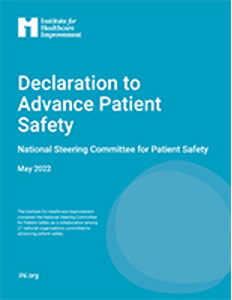Mary Madison, RN, RAC-CT, CDP
Clinical Consultant – Briggs Healthcare
Despite substantial effort over the past 20 years, preventable harm in health care remains a major concern in the United States. Though many evidence-based, effective best practices related to harm reduction have been identified, they are seldom shared nationally and implemented effectively across multiple organizations. Reducing preventable harm requires a concerted, persistent, coordinated effort by all stakeholders, and a total systems approach to safety.
In May 2022, the National Steering Committee for Patient Safety (NSC) issued the Declaration to Advance Patient Safety to urge health care leaders across the continuum of care to recommit to advancing patient and workforce safety.

The NSC called for immediate action to address safety from a total systems approach, as presented in the National Action Plan to Advance Patient Safety, and implored leaders to adopt safety as a core value and foster collective action to uphold this value.

Clicking on the above Download takes you first to a registration page. There is no cost to register.
Recommit to Advance Patient and Workforce Safety
To achieve the vision of health care that is safe, reliable, and free from harm, the Declaration to Advance Patient Safety calls for health care leaders to take collective and coordinated action by doing the following:
- Review the 17 recommendations and tactics to advance patient safety presented in Safer Together: A National Action Plan to Advance Patient Safety*, a report that harnesses the knowledge and insights of the National Steering Committee for Patient Safety members.
- Identify a senior sponsor and core team charged with deploying the Self-Assessment Tool, a companion resource to the National Action Plan, to evaluate your organization’s current state across each of the four foundational areas, prioritized as essential to create total systems safety.
- Establish and enact strategies, tactics, and measurement and improvement plans to meaningfully fortify and sustain your organization’s performance in each of the four foundational areas by leveraging the Implementation Resource Guide, a companion resource to the National Action Plan.
*National Action Plan: 17 Recommendations to Advance Patient Safety
Culture, Leadership, and Governance
1. Ensure safety is a demonstrated core value.
2. Assess capabilities and commit resources to advance safety.
3. Widely share information about safety to promote transparency.
4. Implement competency-based governance and leadership.
Patient and Family Engagement
5. Establish competencies for all health care professionals for the engagement of patients, families, and care partners.
6. Engage patients, families, and care partners in the co-production of care.
7. Include patients, families, and care partners in leadership, governance, and safety and improvement efforts.
8. Ensure equitable engagement for all patients, families, and care partners.
9. Promote a culture of trust and respect for patients, families, and care partners.
Workforce Safety
10. Implement a systems approach to workforce safety.
11. Assume accountability for physical and psychological safety and a healthy work environment that fosters the joy of the health care workforce.
12. Develop, resource, and execute on priority programs that equitably foster workforce safety.
Learning System
13. Facilitate both intra- and inter-organizational learning.
14. Accelerate the development of the best possible safety learning networks.
15. Initiate and develop systems to facilitate interprofessional education and training on safety.
16. Develop shared goals for safety across the continuum of care.
17. Expedite industry-wide coordination, collaboration, and cooperation on safety.
You’ve heard me talk about IHI in past blogs. I’ve been a member since 2016. I encourage you to explore the IHI website to learn more about this organization as well as utilize the resources they provide.
“For 30 years, the Institute for Healthcare Improvement (IHI) has used improvement science to advance and sustain better outcomes in health and health care across the world.
We bring awareness of safety and quality to millions, accelerate learning and the systematic improvement of care, develop solutions to previously intractable challenges, and mobilize health systems, communities, regions, and nations to reduce harm and deaths.
We work in collaboration with the growing IHI community to spark bold, inventive ways to improve the health of individuals and populations.
We generate optimism, harvest fresh ideas, and support anyone, anywhere who wants to profoundly change health and health care for the better.”
